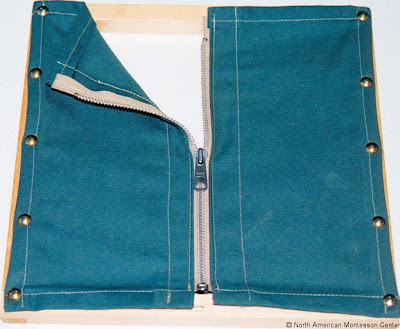
One of the practical life activities that really stands out in a primary Montessori classroom is the rack of dressing frames. The purpose of the dressing frames is to build concentration, coordination and control of movement, all the while encouraging children to become more independent as they learn to care for themselves.
There are several types of dressing frames:
Montessori Classroom Practical Life Activities: The Montessori Dressing Frame

- Zipping Frame
- Bow Frame
- Buttoning (large buttons) Frame
- Buttoning (small buttons) Frame
- Lacing Frame
- Velcro Frame
- Buckling Frame
- Hook and Eye Frame
- Snapping Frame
- Safety Pin Frame
Presentation

- The teacher invites the child to the dressing frame stand and introduces a particular dressing frame, saying "This is the zip dressing frame".
- The teacher models how to carry the dressing frame to the selected work area. The teacher places the dressing frame in front of the child.
- The teacher demonstrates how to unzip by placing the left hand on the left side of the flap and pulling the zipper head down with the right thumb and index finger.
- The teacher then shows the child how to zip up by placing the left hand right at the bottom of the zip, holding both the flaps down. She then pulls the zip head up with the right thumb and index finger of.
- After the lesson is complete, the teacher shows the child how to take the frame and place it back on the dressing frame stand.
As much as possible, NAMC’s web blog reflects the Montessori curriculum as provided in its teacher training programs. We realize and respect that Montessori schools are unique and may vary their schedules and offerings in accordance with the needs of their individual communities. We hope that our readers will find our articles useful and inspiring as a contribution to the global Montessori community.
© North American Montessori Center - originally posted in its entirety at Montessori Teacher Training on Thursday, April 17, 2008.
© North American Montessori Center - originally posted in its entirety at Montessori Teacher Training on Thursday, April 17, 2008.

The best part is to see the smile on a 4-year-old who can successfully tie her own shoe lace after abt 6 mths of practice!
ReplyDeleteIt's all part of that wonderful phrase, "Look! I can do it all by myself!"
ReplyDelete